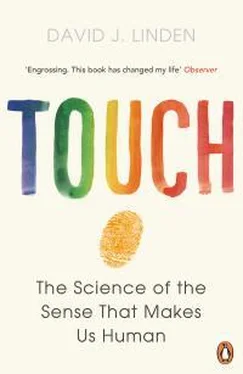17. D. Francis, J. Diorio, D. Liu, and M. J. Meaney, “Nongenomic transmission across generations of maternal behavior and stress responses in the rat,” Science 286 (1999): 1155–58. These experiments had all the clever controls that you would want: pups from low licking-grooming mothers that were cross-fostered to other low licking-grooming mothers and sham-adopted pups that were simply removed from their mothers for a few minutes and then returned.
18. While we don’t yet understand all the cellular and molecular steps that intervene between the tactile sensations received by the newborn pup and the lifelong changes to the stress hormone signaling system, some aspects have been revealed. For example, pups with high licking-grooming mothers have a modification of the gene that codes for the glucocorticoid receptor. This modification, called DNA demethylation, promotes expression of the glucocorticoid receptor gene. The methyl groups attach to a portion of the gene called the promoter and prevent binding of an accessory protein, the transcription factor NGFI-A. When licking-grooming–triggered demethylation occurs in early postnatal life, this allows for expression of the gene, ultimately increasing the levels of glucocorticoid receptor protein and promoting the negative feedback loop that turns down expression of the hypothalamic stress hormone CRH (see figure 1.5). The key feature of this mechanism is that it is epigenetic rather than genetic, meaning that it does not change the series of nucleotides that comprise the individual rat’s genetic code. Rather, it chemically modifies genes to turn their activity up or down. For a nice review of the epigenetics of maternal care in rodents, see A. Kaffman and M. J. Meaney, “Neurodevelopmental sequelae of postnatal maternal care in rodents: clinical and research implications of molecular insights,” Journal of Child Psychology and Psychiatry 48 (2007): 224–44.
19. J. K. Rose, S. Sangha, S. Rai, K. R. Norman, and C. H. Rankin, “Decreased sensory stimulation reduces behavioral responding, retards development, and alters neuronal connectivity in Caenorhabditis elegans ,” Journal of Neuroscience 25 (2005): 7159–68; S. Rai and C. H. Rankin, “Critical and sensitive periods for reversing the effects of mechanosensory deprivation on behavior, nervous system, and development in Caenorhabditis elegans,” Developmental Neurobiology 67 (2007): 1443–56.
20. In affluent households, touch deprivation is likely to occur later in life, with school-age children. The effects of the later deprivation can be serious but not as crucial as that occurring in early life.
21. A classic book that discusses the role of touch in development is T. Field, Touch (Cambridge, MA: MIT Press, 2001). For more recent reviews on this topic, see M. M. Stack and A. D. Jean, “Communicating through touch: touching during parent-infant interactions,” in The Handbook of Touch , M. J. Hertenstein and S. J. Weiss, eds. (New York: Springer, 2011), 273–98; and R. Feldman, “Maternal touch and the developing infant,” in The Handbook of Touch , Hertenstein and Weiss, eds. 373–407.
22. Some recent reviews of kangaroo care include S. Bailey, “Kangaroo mother care,” British Journal of Hospital Medicine 73 (2012): 278–81; and J. E. Lawn, J. Mwansa-Kambafwile, B. L. Horta, F. C. Barros, and S. Cousens, “Kangaroo mother care to prevent neonatal deaths due to preterm birth complications,” International Journal of Epidemiology 39 (2010): 144–54.
23. R. Feldman, Z. Rosenthal, and A. Eidelman, “Maternal-preterm skin-to-skin contact enhances child physiologic organization and cognitive control across the first 10 years of life,” Biological Psychiatry 75 (2014): 56–64.
24. S. E. Jones and A. E. Yarbrough, “A naturalistic study of the meanings of touch,” Communications Monographs 52 (1985): 19–56; and F. N. Willis and C. M. Rinck, “A personal log method for investigating interpersonal touch,” Journal of Psychology 113 (1983): 119–22.
25. M. J. Hertenstein, D. Keltner, B. App, B. A. Bulleit, and A. R. Jaskolka, “Touch communicates distinct emotions,” Emotion 6 (2006): 528–33; M. J. Hertenstein, R. Holmes, M. McCullough, and D. Keltner, “The communication of emotion via touch,” Emotion 9 (2009): 566–73.
26. The world’s leader in the detailed analysis of emotional facial expressions is Paul Ekman. A nice review article he wrote is P. Ekman, “Facial expression and emotion,” American Psychologist 48 (1993): 384–92.
27. M. J. Hertenstein and D. Keltner, “Gender and the communication of emotion via touch,” Sex Roles 64 (2011): 70–80.
28. For those who are interested in the roles of gender and social status in interpersonal touch, I highly recommend the following review article by Judith Hall, which nicely summarizes and synthesizes a rather difficult and sometimes contradictory literature: J. A. Hall, “Gender and status patterns in social touch,” in The Handbook of Touch, M. J. Hertenstein and S. J. Weiss, eds. (New York: Springer, 2011), 329–50. Hall concludes that gender differences in touching and decoding touch cannot be simply explained in terms of a model based upon social status.
29. S. M. Jourard, “An exploratory study of body-accessibility,” British Journal of Social and Clinical Psychology 5 (1966): 221–31. The couples in this study were a mixture of same-sex and opposite-sex pairs. They were not interviewed and they likely represent a mixture of friends and lovers.
30. The British do tend to come out at the bottom of international ranking for social touch. One famous anecdote comes from Prince Charles. He describes a disappointing incident in his boyhood when his mother, the queen, returned from a trip abroad and he was called upon to wait in line with a group of well-wishers for her greeting, which turned out to be only a handshake. Recounted in S. Heller, The Vital Touch (New York: Henry Holt and Company, 1997), 155.
31. E. R. McDaniel and P. A. Andersen, “Intercultural variations in tactile communication,” Journal of Nonverbal Communication 22 (1998): 59–75. The nationalities of the subjects were confirmed by verbal queries after the touches were observed. This study, while interesting, did not have great statistical power and did not sample world cultures broadly: There were no Africans in the data set and few southern Europeans.
CHAPTER TWO: PICK IT UP AND PUT IT IN YOUR POCKET
1. There are several levels of confusion in this question. First, there is a general assumption that sensory experience is a key determinant of intelligence. Yet we know that people who are blind or deaf from birth can have normal intelligence. Second, the precise meanings of phrases like “more acute hearing” and “keener eyesight” are vague. Let’s consider some examples. For the frequencies that dominate in human speech, human hearing is extremely sensitive: In this range we can detect faint sounds as well as any other animal. However, there is a range of low-frequency sounds that can be perceived by elephants, whales, rhinos, and prairie chickens that only weakly activates the sensory apparatus in the human middle ear. Likewise, bats, dogs, dolphins, and mice can detect high-pitched sounds that are above the upper range of human hearing (about 20,000 hertz in children). In the case of vision, hawks (and other birds of prey) have both greater visual acuity than humans (in the ophthalmologist’s office, a hawk would have about 20/2 vision on an eye chart—it can resolve details at 20 feet that the average human could resolve from only 2 feet away) and a broader range of color vision (for example, they can see ultraviolet light emanating from the urine trails of their prey that our eyes cannot detect).
Читать дальше












